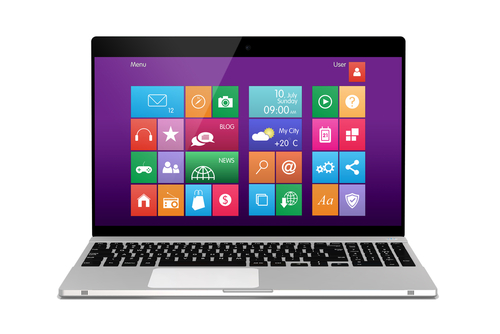December 15th, 2014

The holiday season is typically a busy season for hackers and malware developers. With increased activity online because of online shopping, ecards, emails and more holiday festivities, there are also increased opportunities to infect users with viruses or steal their information. A post at Spyware News details some common methods used to victimize users around the holidays in the past. Here are three to watch for this year.
Think about all the website you visit for the holidays. You may buy airline tickets, book a hotel and order gifts in one afternoon. You’ll also likely be checking you bank accounts during this spending spree. Unfortunately, cyber criminals know that there are millions of other people like you spending money online and they know you’re always looking for a great deal. That gives them the opportunity to make fake websites, or spoof legitimate sites like your bank, in order to infect your computer or steal your payment information. Spotting a fake site can be difficult, depending on how much time has gone into crafting it. An old version of the company’s logo, typos or a missing security step could clue you in. It’s also important to keep your browser and antivirus program updated since they can sometimes alert you to a suspicious website.
Spam coming to your inbox isn’t a problem specific to the holidays, but there are some scams that attempt to use your excitement for the season against you. Many users are directed to the fake websites mentioned above after receiving an email promising a great deal or telling them they’ve won a contest. As always, following links in your email is a risky business. Be especially wary of attachments because that’s a common method for delivering malware. It sounds easy enough to not open attachments, but they’ll be labeled with something enticing that will be difficult to resist.
Not everyone does all of their shopping online. There are still plenty of folks who go out to get their shopping done, but there are dangers there too. Free WiFi at department stores or coffee shops is a convenient way for you to use your smartphone while shopping, but they also allow those with a little know-how to monitor your activity and steal your information. Never make purchases or enter passwords while on a public, unsecured connection.
If you are online during the holidays this year, you’re likely to encounter at least one of these tactics. Staying safe involves have an updated antivirus program installed and being cautious with your activity.
If you do fall victim to one of these attacks, call Geek Rescue at 918-369-4335.
July 30th, 2014

Even with up to date security tools in place, every internet user runs a constant risk of being hacked or infected with malware. Early detection of these issues can save you from a devastating outcome. InfoWorld recently published an article detailing some of the most common and easily spotted signs of malware infections and the action you should take to combat them. Many times, the suggested action is to restore your system to the last known safe point so it’s important that you’re regularly backing up your devices and creating good restore points.
While there’s fewer instances of this tell-tale sign of an infection than in the past, it remains one of the most recognized. Fake antivirus messages can pop up from your desktop or in a browser window. They claim to warn you about malicious files, but in reality the damage has already been done. Malware has already been added to your system. The message exists to entice you into more trouble. Clicking on it often opens a browser window that asks users to purchase security tools. These sites look legitimate, but are actually just a means to steal credit card numbers. The first step for users is to be familiar with what their actual antivirus messages look like. If they see a fake one, power down and restart in safe mode. Try to find the new applications that have been added and remove them. You’ll also want to run a full virus scan.
To be clear, not every browser toolbar is malicious. Google, Yahoo and other legitimate vendors all offer toolbar additions for browsers, but there are scores of toolbars that signal an infection. If you don’t recognize the name associated with the toolbar and don’t remember adding it, your system has likely been compromised. Most browsers offer ways to quickly remove unwanted toolbars and extensions, but some are trickier. You may need to restore your browser to a previous point or restore your entire system.
This often comes in tandem with unwanted browser toolbars. Conducting searches sends you to an unrecognized search engine, which often contains links to sites designed to further infect your device. You may also notice your homepage change. If this is happening, you’ll want to follow similar steps as above. Remove toolbars and other recently added applications, which may require restarting in safe mode.
- Fake Emails Sent From Your Account
If this hasn’t happened to you, you’ve surely received these emails from a contact. It’s a common problem for an email to be hacked and spew spam to the entire address book. What many users don’t know is that this is usually done through a malware infection on your computer. As soon as you notice emails you didn’t personally send in your sent folder, or are alerted by friends that you’ve sent them spam, you’ll want to run a full scan. Then, look around for recently added programs or anything that looks out of the ordinary.
In short, if your device is acting strangely, which can include pop ups, mouse movements, programs being added and more, it’s likely because of malware.
For help removing malware from any of your devices or to improve security, call Geek Rescue at 918-369-4335.
For your business solutions needs, visit our parent company JD Young.
June 19th, 2014

The way smartphones are used is changing. More users are willing to surf the web, and even make purchases with their phones than ever before. Unfortunately, this means that it’s more profitable than ever to launch malware attacks against these devices. At Dark Reading, Kelly Jackson Higgins explains one of the latest threats against Android users and how it could compromise users’ bank accounts.
The attack begins with a fake Google Play store app icon appearing on your device. If you look closely, this fake icon is easy to spot. It’s titled “Googl App Stoy”. This would be a dead giveaway that it’s a fake, but many users fail to look past the official looking logo.
It’s unclear how exactly the malware infects Android devices, but it’s likely done through a malicious app that’s either infiltrated the official Play store or the user downloaded from an unverified location.
The malware lay larges dormant on a device until the fake Play store app is clicked. At that point, it is activated and able to steal banking website log in information, as well as text messages.
What makes this malware particularly dangerous is how difficult it is to get rid of. Only three out of 51 antiviruses tested were able to detect its presence. That’s led to about 200 reported victims over the past 30 days. Complicating matters even further is the app’s supposed ‘Uninstall’ feature. While using ‘Uninstall’ seems to remove the app icon, it reappears and the malware continues to run when the device is restarted.
So far, this attack has only targeted Korean users, but that suggests that users in the US could be targeted soon by this or similar malware.
If your device is infected with malware, or you’d like to find out how to protect yourself better, call Geek Rescue at 918-369-4335.
May 30th, 2014

Implementing proper security features on your computer isn’t high on most individual’s priority list. The assumption is that it will take hours to install new antivirus software and make other necessary changes. But, in reality, some significant improvements can be made in just a few minutes. Andy O’Donnell of About offers his “10-minute security tune-up”. While these won’t make you computer immune to malware infections, they are helpful.
Whether it’s your operating system, browser, antivirus program or other applications, it’s important to keep them updated and install the latest patches released by the developer. It’s a quick and easy process, but it protects you from some of the most dangerous threats to your PC. Patches and updates are often released to fix a vulnerability that has been demonstrated to be exploitable by criminals. So, failing to install these updates leaves a known security flaw open. That’s like asking for trouble. Similarly, updating your antivirus program allows it to stay up to date with the latest recognizable threats so it can identify them on your PC or stop them from infecting it in the first place.
Most users have an antivirus scanner installed on their PC, but have you ever considered the need for a second one? Even if you keep a trusted antivirus program updated, it’s still likely to miss a few threats. Some experts suggest adding a second antivirus scanner to identify problems that would have slipped through. This can potentially cause issues if both antivirus programs are set to actively scan at all times. Instead, you may consider using your primary antivirus program at all times, then run additional, regularly scheduled scans with your secondary scanner.
Regardless of how many security tools you put in place, there is always the chance of a catastrophe. Cyber attacks grow more intelligent every day and it’s impossible to close every potential vulnerability. Even if your PC isn’t taken down by malware, you could lose your data because of a hardware issue or natural disaster. That’s why it’s important to regularly back-up all the important data stored on your hard drive. With cloud storage readily available, you can even store it off site so the loss of your computer doesn’t mean the loss of your back-ups.
As mentioned, no security is perfect. If any of your devices are infected with malware or you’re experiencing other issues, call Geek Rescue at 918-369-4335.
May 19th, 2014

It’s a well-known concern that Android users are much more at risk for malware infections than iOS users. Just a month ago, a fake antivirus app made the rounds in the official Google Play store and victimized a number of users. Google has since offered refunds to those who mistakenly downloaded the malicious app, but it seems they haven’t sufficiently protected against a similar threat reappearing. Lucian Constantin reports at Network World that the Google Play store and the app store for Windows Phones have both recently had malware hidden behind recognizable brand names identified in their stores.
It’s a fairly recent development, but it seems criminal developers are launching malicious apps with well-known company names to further confuse users. This is a well-known tactic of email scams and phishing websites.
One developer account launched malicous apps under the names Avira Antivirus, Mozilla Firefox, Google Chrome, Opera Mobile, Internet Explorer and Safari. The same developer also has a Kaspersky Mobile antivirus app complete with the company’s logo. When downloaded, the app will even simulate a scan of the device’s files.
Making these fake apps more believable, and more costly to users, is that they aren’t free. The Kaspersky Mobile app costs about $4. Most users instinctively trust paid apps more than free ones. A number of free apps have been reported to be malicious, but there’s an implied value tied to something that costs money. It’s also much more believable to pay money for a high quality, big name security app than to get it for nothing.
Some of these apps have been downloaded more than 10-thousand times and even made it onto the “Top Paid” apps list that helps them be further distributed.
Because there has been no sufficient changes made to the Android and Windows Phone app stores, it’s likely that these fake apps will continue to pop-up. However, since many of them steal the exact name of legitimate apps from recognized industry leaders, there’s also likely to be more pressure put on both Google and Microsoft to enhance security.
If you’ve mistakenly downloaded a malicious app, or are having any other kind of trouble with one of your devices, call Geek Rescue at 918-369-4335.
May 16th, 2014

It’s important to have proper security tools in place to protect your computer from attacks and malware. Tools like antivirus programs, firewalls and router security are essential. If you’re a Windows 8 user, you’ve even got some handy built-in security features to assist. At Window Security, Ricky and Monique Magalhaes list the various security features you’ll enjoy with any version of the Windows 8 operating system.
You may not ever notice, but Windows 8 has made a concentrated effort to improve the security associated with wireless internet connections. By extending support to Mobile Extensible Authentication Protocol standards they’ve done just that and made it easier to connect to secure networks.
There are a few different scenarios where you’d need to remotely remove data from your device. If a device is lost or stolen, or if your company allows employees to bring their own device and you need to remove data after an employee has left the organization are just a couple. Windows 8 includes a remote data removal feature to help protect both users and administrators.
Windows 8 offers Unified Extensible Firmware Interface, or UEFI, which probably doesn’t mean much to you. It’s an interface between the operating system and the firmware that’s a significant upgrade in security over previous operating systems. When attackers gain access to and manipulate the firmware, it’s extremely bad for the user. UEFI keeps this from happening.
Windows Defender comes with Windows 8 and while that isn’t a new feature, it does have enhanced performance and decreased memory usage. While Defender and other features of Microsoft Security Essentials are useful, they’ve never been meant as stand alone security solutions. Using them in addition to other antivirus and anti-malware programs creates a more secure environment.
Improved and added security features in Windows 8 aren’t limited to what’s listed here. Microsoft clearly concentrated on improving security for their users with the latest version of their operating system, but that doesn’t mean that using Windows 8 security features alone will keep you safe from malware. These features are only a part of an effective security infrastructure.
For help with security for your PC or business, or to recover from an attack or malware infection, call Geek Rescue at 918-369-4335.
May 15th, 2014

The hard truth is that it’s extremely difficult to effectively secure a business from cyber attacks, malware and data breaches. It’s also vital to managing a successful business, however. At Dark Reading, Mark Goldstein and Arun Sood published a list of common security myths that hinder both the understanding and the effectiveness of a company’s security infrastructure.
What is adequate in the context of data security? The truth is that no system is 100-percent effective. Successful attacks are unavoidable because it’s impossible to secure every endpoint while simultaneously dealing with thousands of new pieces of malware each day. The key is to minimize the risk and the damage and have a plan in place to recover and mitigate attacks.
Many business owners believe that server and security management is as simple as getting everything online, then dealing with problems as they arise. That’s one way, but that introduces a number of potential problems. First, by not being proactive and looking ahead for issues that could happen in the future, you’re actually likely to have more problems and more downtime. Similarly, while static systems cost less and require fewer man hours, they also create an unchanging target for attackers.
- All Threats Demand Action
Common sense suggests that any time there’s an intrusion or a vulnerability, your IT team needs to take action. In reality, however, reacting the same to every threat only means that you’re unable to react sufficiently to the most dire of threats. IT professionals understand that there are minor attacks that can’t do any real damage. It’s unwise for these threats to trigger the same alarms as large scale attacks because it increases the chances that one of these serious threats gets missed or overlooked.
- Patch All Vulnerabilities
In the same vein, don’t expect to be able to patch and close all security vulnerabilities that exist on your network. New vulnerabilities are added every day, or even every hour. With tens of thousands of vulnerabilities, it’s impossible and a waste of time to try to secure each of them. Instead, good IT professionals know how to spot the most dangerous vulnerabilities and patch them immediately. This is a more efficient use of time and keeps the most dangerous threats out while protecting your most valuable assets.
If you need to improve the security at your business, call Geek Rescue for help at 918-369-4335.
May 13th, 2014

You may already know that effectively implementing security into your IT infrastructure is a vital step towards protecting your business, but unfortunately you likely aren’t working with a limitless budget. Anyone can secure their business with an endless flow of cash, but it becomes much more difficult when you’re having to decide what’s worth the money and what isn’t. At Network World, George V. Hulme gives some tips for how best to use your security budget to get the most out of your investment.
As time marches on, you’re business will need new security tools. This is either because the tools you had in place are no longer effective against current threats, or because your infrastructure has changed enough to warrant a change in security. When that happens, adding new tools is great, but decommissioning the now obsolete tools is just as important. Too many business owners have no process for removing security applications from their infrastructure when they’re no longer needed. Many aren’t able to recognize which tools have become redundant and won’t hurt to be decommissioned. Trimming out these old security tools also trims the budget.
All of that said, before you invest in a new application or new equipment, be sure you actually need it and will be able to effectively use it. A chief security officer suggests asking yourself three questions:
Are their people on staff who know how to use this?
Do they have the time to install, use, maintain and manage it?
Will it have an effect?
Investing in new technology that won’t benefit your business is obviously foolish. But, many don’t recognize that even technology that will positively affect their business shouldn’t be implemented without the proper staff in place.
When it comes to effectively staffing your IT department, you aren’t always saving money when you think you are. Many business owners believe they can cut corners and staff fewer professionals in order to save money. But, this often leads to more downtime and less security in place, which can lead to successful attacks, malware infections and data theft. All of these cost you money and productivity. There’s likely to be a shortage of qualified IT professionals in the coming years so investing in IT now can save you from being dangerously under-staffed later.
Properly using your IT budget can be difficult. At Geek Rescue, we provide IT solutions for businesses on any scale. Our clients receive the benefit of an entire IT staff without having to deal with the headaches of actually hiring and maintaining an IT department.
To learn more, call us at 918-369-4335.
May 12th, 2014

When it comes to setting up and effectively managing your company’s IT infrastructure, there are a number of decisions to be made. Unfortunately, there’s also plenty of bad information being peddled by so-called experts and vendors. At Tech World, Roger A. Grimes published a list of “promises that don’t deliver” concerning specifically IT security. Avoiding these misconceptions helps you create a more effective infrastructure.
- Invulnerable Applications
The idea of software that is unbreakable, unhackable and totally secure is naturally attractive, but it’s a myth. Even the most painstakingly crafted applications contain flaws that eventually allow them to be hacked. A popular cry from vendors is to tout software as unbreakable, but in reality this only invites more trouble. Publicly claiming that software contains no vulnerabilities only places a target on that software. Many times, this software ends up being routinely attacked and being one of the least trusted applications available.
Encryption is a valuable security tool, but it’s incredibly difficult to create strong encryption. There are many who claim to offer unbreakable encryption, but with few exceptions encryption is hard to break, but not impossible. One characteristic that suggests a vendor’s encryption is not worth your money is the promise of thousands to millions of bits for the key. Typically, strong encryption tops out at 2048-bit keys. Anything larger is unnecessary and actually gives intelligent attackers more opportunities to find flaws and break the code. Million-bit encryption would also require a large amount of data and be difficult to send anywhere thanks to prohibitive file sizes.
This myth is a little more well-known than the others but it also leads to a large portion of successful attacks. The truth is that no one is ever truly, full secure. No antivirus is capable of catching ever possible attack and malware before it happens. Most won’t even be able to spot every piece of malware already installed on a device. The belief that a perfect antivirus program is possible, however, leads to irresponsible actions. Users put themselves in harms way because they believe their antivirus program will protect them from anything that comes along. If you want a perfect antivirus program, don’t rely on it. The better the user’s behavior and habits, the more fewer problems you’ll encounter. To get the truth about what’s needed for your company’s IT infrastructure, call Geek Rescue at 918-369-4335.
May 8th, 2014

Twice each year, Microsoft releases a Security Intelligence Report detailing the security issues that have plagued users over the previous few months. The latest edition was released this week and reveals an alarming growth in the number of Windows users who are infected with some type of malware. At PC World, Jeremy Kirk reports on the threat that is primarily responsible for this rash of malware infections.
The problem isn’t just that there are more infected users than expected, but that the number of infected users has tripled in a short time. During the third quarter of 2013, it was estimated that less than 6 Windows users per 1-thousand were infected with malware. By the end of 2013, that number had escalated to 17 out of every 1-thousand users.
A malicous program called ‘Rotbrow’ is identified as the primary reason for the quick growth of infected users. At issue is that Rotbrow was only recently identified as malware. It’s been around for quite some time and has infected a number of computers, but it never showed any malicious activities until now.
Rotbrow is disguised as a browser add-on that supposedly helps with security. In reality, it’s what’s known as a ‘dropper’. This is a type of malware that downloads and installs other malicious software to a computer.
In the case of Rotbrow, it waited weeks, or even months, before it started any malicious activities. When it began downloading other malware, security developers quickly added it to a list of recognized malware, but by then it had already been allowed to infect users worldwide. At the time of the Security Intelligence Report’s release, Rotbrow was estimated to be on 59 out of every 1-thousand Windows machines.
The existence of Rotbrow alone isn’t a huge concern except that it often downloads malware capable of much more sinister activities, including ransomware that locks users out of their own computers.
Most security tools are now capable of detecting Rotbrow and blocking it from infecting a new computer, but only if a user’s antivirus program is updated. If yours isn’t, update immediately and scan your computer for malware.
If any of your devices have malware or other issues, call Geek Rescue at 918-369-4335.



















